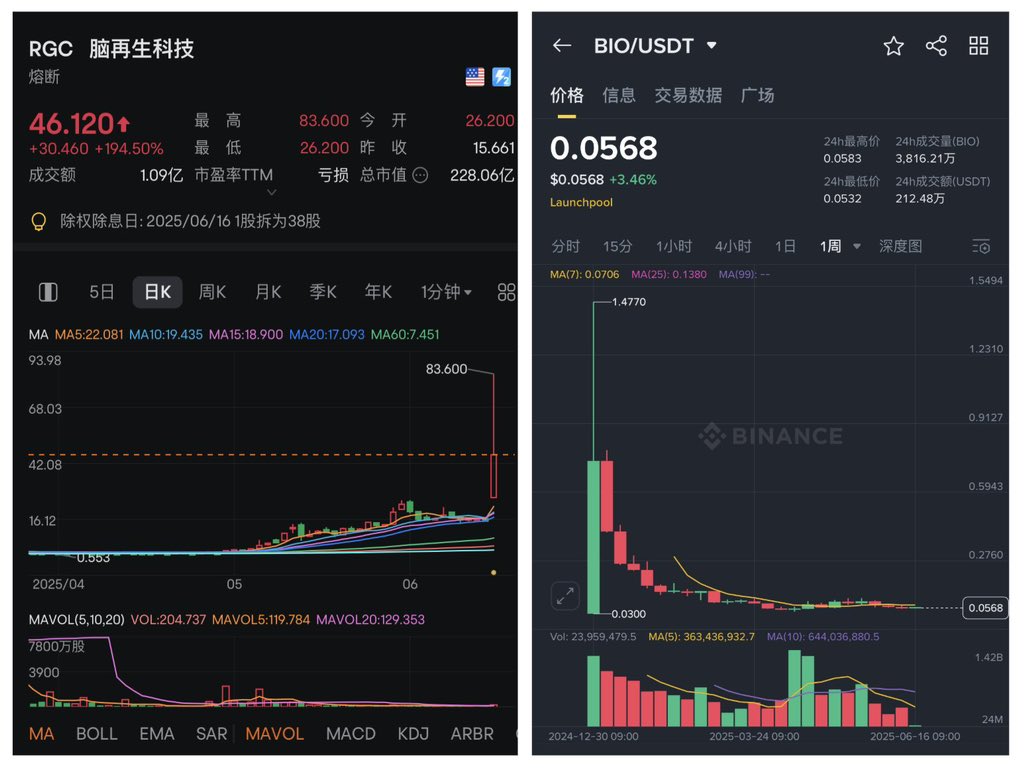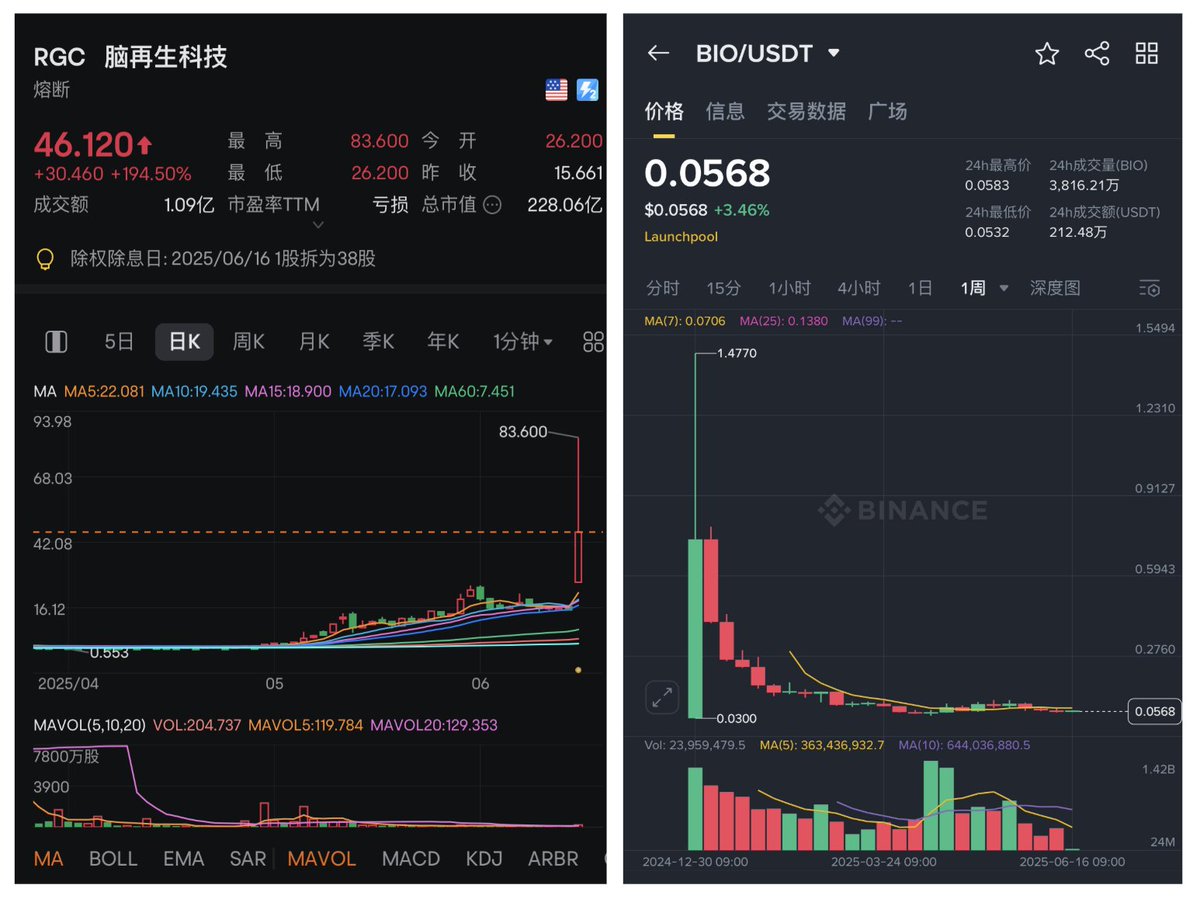
BIO
Cours du BIO
$0,042050
-$0,00472
(-10,10 %)
Évolution du cours sur les dernières 24 heures

Avis de non-responsabilité
Le contenu social sur cette page (« Contenu »), y compris mais sans s’y limiter les tweets et les statistiques fournis par LunarCrush, est issu de tiers et fourni « tel quel » à des fins d’information uniquement. OKX ne garantit ni la qualité ni l’exactitude du Contenu, et le Contenu ne représente pas les opinions d’OKX. Il n’est pas destiné à dispenser (i) des conseils ou recommandations en matière d’investissement ; il ne doit pas (ii) non plus être considéré comme une invitation à acheter, à vendre ni à détenir des actifs numériques, ni (iii) comme des conseils financiers, comptables, juridiques ou fiscaux. Les actifs numériques (dont les stablecoins et les NFT) présentent un niveau de risque élevé, et leur valeur peut varier considérablement. Les cours et les performances des actifs numériques ne sont pas garantis et peuvent changer sans préavis.OKX ne fournit aucune recommandation en matière d’investissement ou d’actif. Évaluez attentivement votre situation financière pour déterminer si vous êtes en mesure de détenir ou de trader des actifs numériques. Demandez conseil auprès de votre expert juridique, fiscal ou en investissement pour toute question portant sur votre situation personnelle. Pour plus de détails, consultez nos Conditions d’utilisation et notre Avertissement sur les risques. En utilisant le site Web tiers (« SWT »), vous acceptez que toute utilisation du SWT soit soumise et régie par les conditions du SWT. Sauf mention écrite expresse, OKX et ses sociétés affiliées (« OKX ») ne sont en aucun cas associées au propriétaire ou à l’exploitant du SWT. Vous acceptez qu’OKX ne soit responsable d’aucune perte, d’aucun dommage et d’aucune autre conséquence découlant de votre utilisation du SWT. Sachez que l’utilisation d’un SWT peut déboucher sur la perte ou la baisse de vos actifs. Le produit peut être indisponible dans certaines juridictions.
Infos sur le marché du BIO
Cap. boursière
La cap. boursière est calculée en multipliant l’offre en circulation d’un jeton par son dernier cours.
Cap. boursière = offre en circulation × dernier cours
Cap. boursière = offre en circulation × dernier cours
Approvisionnement en circulation
La quantité totale d’un jeton qui est accessible au public sur le marché.
Classement de cap. boursière
La position d’un jeton dans le classement par cap. boursière.
Sommet historique
Cours le plus élevé atteint par un jeton au cours de son historique de trading.
Minimum historique
Cours le plus bas atteint par un jeton au cours de son historique de trading.
Cap. boursière
$75,45M
Approvisionnement en circulation
1 791 355 331 BIO
53,95 % de
3 320 000 000 BIO
Classement de cap. boursière
--
Audits
CertiK
Dernier audit : --
Pic sur 24 h
$0,047100
Creux sur 24 h
$0,041940
Sommet historique
$0,90750
-95,37 % (-$0,86545)
Dernière mise à jour : 3 janv. 2025, (UTC+8)
Minimum historique
$0,040470
+3,90 % (+$0,0015800)
Dernière mise à jour : 17 avr. 2025, (UTC+8)
Que ressentez-vous pour BIO aujourd’hui ?
Donnez votre avis en ajoutant un pouce vers le haut si vous pensez que le cours Ethereum et la valeur Ethereum sont en hausse, ou un pouce en bas si vous estimez que le prix Ethereum et le ETH / USD vont baisser. Suivez l’évolution Ethereum en temps réel et consultez le Ethereum cours dollar et le Ethereum cours euro pour anticiper les tendances du marché.
Votez pour voir les résultats
Flux de BIO
Le contenu suivant provient de .

쓰니 | SSUNI (APT/KAIA/ACC) 🇰🇷
Je ne peux pas simplement ignorer le tweet à propos de @BasisOS $BIO, qui a été rempli de discussions et de controverses. Comme tout le monde le sait, la saison 1 du minage MyShare de @BasisOS s'est terminée le 29 juillet. En regardant en arrière depuis la fin avril, je ne peux m'empêcher de ressentir un peu de regret, en pensant que j'aurais dû commencer un peu plus tôt. Je ressens cela depuis un moment, mais honnêtement, il n'y a rien à écrire. Il semble qu'il n'y ait eu aucune nouvelle mise à jour, et il est difficile de trouver un tweet sur le farming. @virtuals_io
Afficher l’original8,57 k
1

Dr.UZ
Il y a six mois, si vous aviez investi dans le #DeSci (science décentralisée) $BIO,
plutôt que dans le #TraSci (science centralisée) $RGC sur le marché américain,
vous auriez obtenu un retour de 350 fois.
Quel bordel
Il vaut mieux investir dans des entreprises cotées pour les technologies avancées, et dans le domaine des cryptomonnaies, il suffit d'acheter celles qui sont liées à l'innovation financière 😅😅
Mais $pythia 🧠🐁 est une exception 😎, car $pythia est soutenu par une entreprise cotée.


AB Kuai.Dong
Il y a six mois, si vous aviez investi dans la DeSci (science décentralisée) du monde des cryptomonnaies, au lieu de la technologie régénérative des actions américaines (science centralisée), vous auriez obtenu un retour de 350 fois.

24,47 k
36

쓰니 | SSUNI (APT/KAIA/ACC) 🇰🇷
En regardant ce problème de quantité avec @BasisOS, j'ai quelques réflexions. Depuis que j'ai posté l'image de minage sur Twitter pour le farming social, il n'est pas facile de vérifier la quantité et d'avoir des preuves claires pour la comparaison.
Mais je pense aussi beaucoup car des ajustements de quantité étaient possibles. $BIO
Afficher l’original10,91 k
3

쓰니 | SSUNI (APT/KAIA/ACC) 🇰🇷
Ah, je dois écrire sur @BasisOS. Personnellement, je l'ai trouvé intéressant lorsque je l'ai rencontré pour la première fois.
Il y a beaucoup de discussions, mais je me demande s'il serait plus amusant que des projets similaires continuent à être lancés sur le marché ou si des projets capables de créer des synergies émergent. Je ne pense pas que ce soit un projet qui disparaîtra du jour au lendemain, n'est-ce pas ? Ou peut-être que si. Qui sait ! $BIO @virtuals_io
Afficher l’original11,86 k
4
Convertir des USD en BIO


Performance du cours de BIO en USD
Le cours actuel de la crypto BIO est de $0,042050. Au cours des 24 dernières heures, la crypto BIO a a diminué de -10,09 %. Son offre en circulation s’élève actuellement à 1 791 355 331 BIO, et son offre maximale est de 3 320 000 000 BIO, ce qui lui confère une capitalisation boursière totalement diluée de $75,45M. Actuellement, le jeton BIO occupe la 0e position dans le classement de la cap. boursière. Le cours de la paire BIO/USD est mis à jour en temps réel.
Aujourd'hui
-$0,00472
-10,10 %
7 jours
-$0,01271
-23,22 %
30 jours
-$0,04805
-53,33 %
3 mois
-$0,05761
-57,81 %
Conversions de BIO populaires
Dernière mise à jour : 23/06/2025 04:15
| 1 BIO en USD | 0,042120 $ |
| 1 BIO en EUR | 0,036548 € |
| 1 BIO en PHP | 2,4081 ₱ |
| 1 BIO en IDR | 691,51 Rp |
| 1 BIO en GBP | 0,031374 £ |
| 1 BIO en CAD | 0,057895 $ |
| 1 BIO en AED | 0,15469 AED |
| 1 BIO en VND | 1 100,60 ₫ |
À propos du BIO (BIO)
La notation fournie correspond à une notation agrégée qui est collectée par OKX à partir des sources fournies. Elle n’est indiquée qu’à titre indicatif. OKX ne garantit ni la qualité ni l’exactitude des notations. Elle n’est pas destinée à dispenser (i) des conseils ou recommandations en matière d’investissement ; elle ne doit pas (ii) non plus être considérée comme une invitation à acheter, à vendre ni à détenir des actifs numériques, ni (iii) comme des conseils financiers, comptables, juridiques ou fiscaux. Les actifs numériques (dont les stablecoins et les NFT) présentent un niveau de risque élevé ; leur valeur peut varier considérablement, voire devenir nulle. Les prix et les performances des actifs numériques ne sont pas garantis et peuvent changer sans préavis. Vos actifs numériques ne sont pas couverts par une assurance contre les pertes potentielles. Les rendements historiques ne constituent pas un indicateur des rendements futurs. OKX ne garantit aucun rendement, ni le remboursement du capital et des intérêts. Évaluez attentivement votre situation financière pour déterminer si vous êtes en mesure de détenir des actifs numériques ou de réaliser des activités de trading. Demandez conseil auprès de votre expert juridique/fiscal/en investissement pour toute question portant sur votre propre situation.
Afficher plus
- Site web officiel
- Livre blanc
- Explorateur de blocs
À propos des sites Web tiers
À propos des sites Web tiers
En utilisant le site web tiers (« SWT »), vous acceptez que toute utilisation du SWT soit sujette aux conditions du SWT et gouvernée par celles-ci. Sauf mention écrite expresse, OKX et ses affiliés (« OKX ») ne sont en aucun cas associés au propriétaire ni à l’opérateur du SWT. Vous acceptez le fait qu’OKX ne soit pas responsable des pertes, dommages ni de toutes autres conséquences découlant de votre utilisation du SWT. Veuillez noter que l’utilisation d’un SWT peut entraîner une perte ou une diminution de vos actifs.
FAQ BIO
Combien vaut 1 BIO aujourd’hui ?
Actuellement, 1 BIO vaut $0,042050. Vous recherchez des informations sur les mouvements de prix du token BIO ? Vous êtes au bon endroit ! Découvrez les graphiques les plus récents sur le token BIO et tradez de manière responsable avec OKX.
Qu'est-ce que la cryptomonnaie ?
Les cryptomonnaies, telles que les BIO, sont des actifs numériques fonctionnant sur un registre public appelé blockchain. En savoir plus sur les jetons proposés sur OKX et leurs différents attributs, notamment le cours en direct et les graphiques en temps réel.
Quand la cryptomonnaie a-t-elle été inventée ?
En raison de la crise financière de 2008, l’intérêt porté à la finance décentralisée a explosé. Le Bitcoin offrait une solution novatrice en tant qu’actif numérique sécurisé sur un réseau décentralisé. De nombreux jetons tels que les BIO ont également été créés depuis lors.
Le cours du BIO va-t-il augmenter aujourd'hui ?
Consultez notre Page de prédiction des cours de BIO pour prévoir les cours à venir et déterminer vos objectifs de cours.
Déclaration ESG
Les réglementations ESG (approche environnementale, sociale et de gouvernance) relatives aux actifs crypto visent à réduire leur impact environnemental (par exemple : l'extraction minière à forte intensité énergétique), à promouvoir la transparence et à garantir des pratiques de gouvernance éthiques afin d'aligner le secteur des cryptos sur des objectifs plus larges en matière de durabilité et de société. Ces réglementations encouragent le respect de normes qui atténuent les risques et favorisent la confiance dans les actifs numériques.
Détails de l’actif
Nom
OKcoin Europe LTD
Identifiant de l’entité juridique concernée
54930069NLWEIGLHXU42
Nom de l’actif crypto
BIO
Mécanisme de consensus
BIO is present on the following networks: Base, Ethereum, Solana.
Base is a Layer-2 (L2) solution on Ethereum that was introduced by Coinbase and developed using Optimism's OP Stack. L2 transactions do not have their own consensus mechanism and are only validated by the execution clients. The so-called sequencer regularly bundles stacks of L2 transactions and publishes them on the L1 network, i.e. Ethereum. Ethereum's consensus mechanism (Proof-of-stake) thus indirectly secures all L2 transactions as soon as they are written to L1.
The crypto-asset's Proof-of-Stake (PoS) consensus mechanism, introduced with The Merge in 2022, replaces mining with validator staking. Validators must stake at least 32 ETH every block a validator is randomly chosen to propose the next block. Once proposed the other validators verify the blocks integrity. The network operates on a slot and epoch system, where a new block is proposed every 12 seconds, and finalization occurs after two epochs (~12.8 minutes) using Casper-FFG. The Beacon Chain coordinates validators, while the fork-choice rule (LMD-GHOST) ensures the chain follows the heaviest accumulated validator votes. Validators earn rewards for proposing and verifying blocks, but face slashing for malicious behavior or inactivity. PoS aims to improve energy efficiency, security, and scalability, with future upgrades like Proto-Danksharding enhancing transaction efficiency.
Solana uses a unique combination of Proof of History (PoH) and Proof of Stake (PoS) to achieve high throughput, low latency, and robust security. Here’s a detailed explanation of how these mechanisms work: Core Concepts 1. Proof of History (PoH): Time-Stamped Transactions: PoH is a cryptographic technique that timestamps transactions, creating a historical record that proves that an event has occurred at a specific moment in time. Verifiable Delay Function: PoH uses a Verifiable Delay Function (VDF) to generate a unique hash that includes the transaction and the time it was processed. This sequence of hashes provides a verifiable order of events, enabling the network to efficiently agree on the sequence of transactions. 2. Proof of Stake (PoS): Validator Selection: Validators are chosen to produce new blocks based on the number of SOL tokens they have staked. The more tokens staked, the higher the chance of being selected to validate transactions and produce new blocks. Delegation: Token holders can delegate their SOL tokens to validators, earning rewards proportional to their stake while enhancing the network's security. Consensus Process 1. Transaction Validation: Transactions are broadcast to the network and collected by validators. Each transaction is validated to ensure it meets the network’s criteria, such as having correct signatures and sufficient funds. 2. PoH Sequence Generation: A validator generates a sequence of hashes using PoH, each containing a timestamp and the previous hash. This process creates a historical record of transactions, establishing a cryptographic clock for the network. 3. Block Production: The network uses PoS to select a leader validator based on their stake. The leader is responsible for bundling the validated transactions into a block. The leader validator uses the PoH sequence to order transactions within the block, ensuring that all transactions are processed in the correct order. 4. Consensus and Finalization: Other validators verify the block produced by the leader validator. They check the correctness of the PoH sequence and validate the transactions within the block. Once the block is verified, it is added to the blockchain. Validators sign off on the block, and it is considered finalized. Security and Economic Incentives 1. Incentives for Validators: Block Rewards: Validators earn rewards for producing and validating blocks. These rewards are distributed in SOL tokens and are proportional to the validator’s stake and performance. Transaction Fees: Validators also earn transaction fees from the transactions included in the blocks they produce. These fees provide an additional incentive for validators to process transactions efficiently. 2. Security: Staking: Validators must stake SOL tokens to participate in the consensus process. This staking acts as collateral, incentivizing validators to act honestly. If a validator behaves maliciously or fails to perform, they risk losing their staked tokens. Delegated Staking: Token holders can delegate their SOL tokens to validators, enhancing network security and decentralization. Delegators share in the rewards and are incentivized to choose reliable validators. 3. Economic Penalties: Slashing: Validators can be penalized for malicious behavior, such as double-signing or producing invalid blocks. This penalty, known as slashing, results in the loss of a portion of the staked tokens, discouraging dishonest actions.
Mécanismes d’incitation et frais applicables
BIO is present on the following networks: Base, Ethereum, Solana.
Base is a Layer-2 (L2) solution on Ethereum that uses optimistic rollups provided by the OP Stack on which it was developed. Transaction on base are bundled by a, so called, sequencer and the result is regularly submitted as an Layer-1 (L1) transactions. This way many L2 transactions get combined into a single L1 transaction. This lowers the average transaction cost per transaction, because many L2 transactions together fund the transaction cost for the single L1 transaction. This creates incentives to use base rather than the L1, i.e. Ethereum, itself. To get crypto-assets in and out of base, a special smart contract on Ethereum is used. Since there is no consensus mechanism on L2 an additional mechanism ensures that only existing funds can be withdrawn from L2. When a user wants to withdraw funds, that user needs to submit a withdrawal request on L1. If this request remains unchallenged for a period of time the funds can be withdrawn. During this time period any other user can submit a fault proof, which will start a dispute resolution process. This process is designed with economic incentives for correct behaviour.
The crypto-asset's PoS system secures transactions through validator incentives and economic penalties. Validators stake at least 32 ETH and earn rewards for proposing blocks, attesting to valid ones, and participating in sync committees. Rewards are paid in newly issued ETH and transaction fees. Under EIP-1559, transaction fees consist of a base fee, which is burned to reduce supply, and an optional priority fee (tip) paid to validators. Validators face slashing if they act maliciously and incur penalties for inactivity. This system aims to increase security by aligning incentives while making the crypto-asset's fee structure more predictable and deflationary during high network activity.
Solana uses a combination of Proof of History (PoH) and Proof of Stake (PoS) to secure its network and validate transactions. Here’s a detailed explanation of the incentive mechanisms and applicable fees: Incentive Mechanisms 4. Validators: Staking Rewards: Validators are chosen based on the number of SOL tokens they have staked. They earn rewards for producing and validating blocks, which are distributed in SOL. The more tokens staked, the higher the chances of being selected to validate transactions and produce new blocks. Transaction Fees: Validators earn a portion of the transaction fees paid by users for the transactions they include in the blocks. This provides an additional financial incentive for validators to process transactions efficiently and maintain the network's integrity. 5. Delegators: Delegated Staking: Token holders who do not wish to run a validator node can delegate their SOL tokens to a validator. In return, delegators share in the rewards earned by the validators. This encourages widespread participation in securing the network and ensures decentralization. 6. Economic Security: Slashing: Validators can be penalized for malicious behavior, such as producing invalid blocks or being frequently offline. This penalty, known as slashing, involves the loss of a portion of their staked tokens. Slashing deters dishonest actions and ensures that validators act in the best interest of the network. Opportunity Cost: By staking SOL tokens, validators and delegators lock up their tokens, which could otherwise be used or sold. This opportunity cost incentivizes participants to act honestly to earn rewards and avoid penalties. Fees Applicable on the Solana Blockchain 7. Transaction Fees: Low and Predictable Fees: Solana is designed to handle a high throughput of transactions, which helps keep fees low and predictable. The average transaction fee on Solana is significantly lower compared to other blockchains like Ethereum. Fee Structure: Fees are paid in SOL and are used to compensate validators for the resources they expend to process transactions. This includes computational power and network bandwidth. 8. Rent Fees: State Storage: Solana charges rent fees for storing data on the blockchain. These fees are designed to discourage inefficient use of state storage and encourage developers to clean up unused state. Rent fees help maintain the efficiency and performance of the network. 9. Smart Contract Fees: Execution Costs: Similar to transaction fees, fees for deploying and interacting with smart contracts on Solana are based on the computational resources required. This ensures that users are charged proportionally for the resources they consume.
Début de la période à laquelle se rapporte la déclaration
2024-06-14
Fin de la période à laquelle se rapporte la déclaration
2025-06-14
Rapport sur l'énergie
Consommation énergétique
285.86520 (kWh/a)
Consommation d’énergie renouvelable
26.542366745 (%)
Intensité énergétique
0.00004 (kWh)
Principales sources d’énergie et méthodologies
To determine the proportion of renewable energy usage, the locations of the nodes are to be determined using public information sites, open-source crawlers and crawlers developed in-house. If no information is available on the geographic distribution of the nodes, reference networks are used which are comparable in terms of their incentivization structure and consensus mechanism. This geo-information is merged with public information from Our World in Data, see citation. The intensity is calculated as the marginal energy cost wrt. one more transaction.
Ember (2025); Energy Institute - Statistical Review of World Energy (2024) – with major processing by Our World in Data. “Share of electricity generated by renewables – Ember and Energy Institute” [dataset]. Ember, “Yearly Electricity Data Europe”; Ember, “Yearly Electricity Data”; Energy Institute, “Statistical Review of World Energy” [original data]. Retrieved from https://ourworldindata.org/grapher/share-electricity-renewables
Sources de consommation d’énergie et méthodologies
The energy consumption of this asset is aggregated across multiple components:
To determine the energy consumption of a token, the energy consumption of the network(s) base, ethereum, solana is calculated first. For the energy consumption of the token, a fraction of the energy consumption of the network is attributed to the token, which is determined based on the activity of the crypto-asset within the network. When calculating the energy consumption, the Functionally Fungible Group Digital Token Identifier (FFG DTI) is used - if available - to determine all implementations of the asset in scope. The mappings are updated regularly, based on data of the Digital Token Identifier Foundation.
Rapport sur les émissions
Emissions de GES de portée 1 DLT - Contrôlé
0.00000 (tCO2e/a)
Emissions de GES de portée 2 DLT - Acheté
0.09515 (tCO2e/a)
Intensité des GES
0.00001 (kgCO2e)
Principales sources de GES et méthodologies
To determine the GHG Emissions, the locations of the nodes are to be determined using public information sites, open-source crawlers and crawlers developed in-house. If no information is available on the geographic distribution of the nodes, reference networks are used which are comparable in terms of their incentivization structure and consensus mechanism. This geo-information is merged with public information from Our World in Data, see citation. The intensity is calculated as the marginal emission wrt. one more transaction.
Ember (2025); Energy Institute - Statistical Review of World Energy (2024) – with major processing by Our World in Data. “Carbon intensity of electricity generation – Ember and Energy Institute” [dataset]. Ember, “Yearly Electricity Data Europe”; Ember, “Yearly Electricity Data”; Energy Institute, “Statistical Review of World Energy” [original data]. Retrieved from https://ourworldindata.org/grapher/carbon-intensity-electricity Licenced under CC BY 4.0
Convertir des USD en BIO













